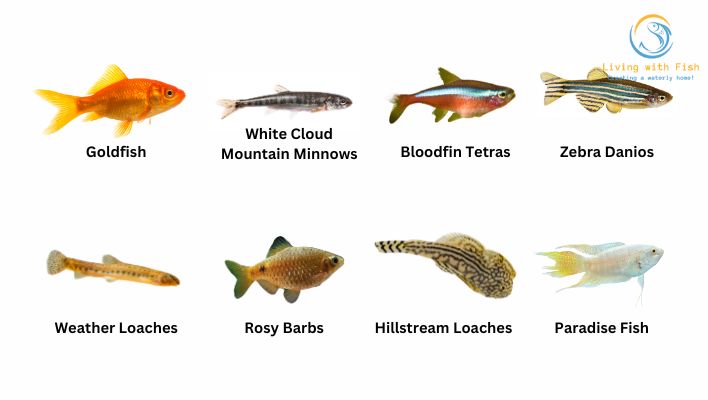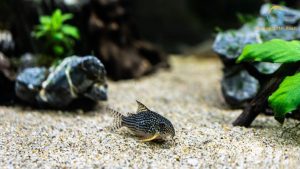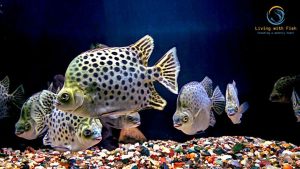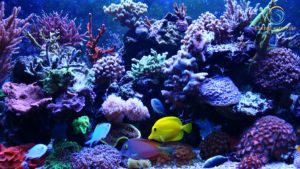This article covers the following areas –
- What is a Cold Water Aquarium?
- Benefits of a Cold Water Aquarium
- A Guide to Selecting the Best Cold Water Aquarium Fish
- Care and Maintenance for Cold Water Fish
- In Conclusion

Setting up a cold water aquarium opens up a world of possibilities, with a myriad of unique and resilient species that can thrive in cooler environments. Whether you’re a seasoned aquarist looking for a new challenge or a beginner seeking a low-maintenance aquarium, this guide will help you navigate your choices and introduce you to some of the best cold-water aquarium fish.
When selecting the best cold water aquarium fish, consider factors such as the fish’s size, temperament, diet, and care requirements. Popular choices include Goldfish, White Cloud Mountain Minnows, Bloodfin Tetras, and Zebra Danios, renowned for their hardiness and adaptability.
For a more comprehensive guide on cold water aquariums, their advantages, and tips for selecting the right fish, continue reading this article. It delves into essential factors to consider when choosing fish, highlights popular cold-water fish species, and provides guidance on their care and maintenance.
What is a Cold Water Aquarium?
A cold water aquarium is a type of aquatic habitat purposefully maintained at lower temperatures. In the context of home aquariums, this typically refers to temperatures below 70°F (21°C), but above freezing point. Unlike tropical fish tanks that require heaters to achieve and maintain the warmth necessary for tropical fish species, cold water tanks usually don’t require additional heating. This very feature makes them more energy-efficient and potentially cost-effective in the long run.
These setups are specifically designed for fish species that thrive in cooler waters. These species are typically native to temperate regions where they have adapted to seasonal changes and fluctuating temperatures. However, it’s important to note that “cold” doesn’t mean room temperature. The optimal temperature for your cold water aquarium will depend on the specific needs of the fish species you choose to house.
Benefits of a Cold Water Aquarium
Many advantages come with setting up and maintaining a cold water aquarium. For one, they are generally easier and less expensive to maintain than tropical tanks. This is largely because the lower water temperatures slow down the metabolism of cold-water fish. With a slower metabolic rate, these fish produce less waste, which means your tank stays cleaner for longer and requires fewer water changes.
Another major benefit is the hardiness and adaptability of cold-water fish. These species have evolved to survive in a variety of conditions, making them more resilient to changes in their environment compared to many tropical species. This makes cold water fish an excellent choice for beginners in the hobby who might still be learning the ropes of maintaining stable tank conditions.
Additionally, cold water aquariums present a unique visual appeal. They offer a chance to create a distinct, mesmerizing aquatic display that stands out from the typical tropical setups. A well-maintained cold water tank can be a conversation starter and a tranquil addition to your living space.
Lastly, they’re more energy-efficient because these aquariums don’t require additional heating. This not only contributes to lower utility bills, but it’s also a more environmentally friendly option.
While cold water aquariums offer many benefits, it’s important to remember that each type of aquarium setup comes with its own challenges. Choosing the type of aquarium that suits you best will depend on your personal preferences, commitment level, and the specific care requirements of the fish species you wish to keep.
A Guide to Selecting the Best Cold Water Aquarium Fish
Choosing the right fish for your cold water aquarium involves more than just selecting those that can live in cooler temperatures. You also need to consider various factors such as the fish’s size, temperament, dietary requirements, and care needs.
Further, it’s also vital to ensure compatibility among the species in your tank to maintain a peaceful and thriving aquatic environment. This section offers a guide to selecting suitable fish species for your cold water aquarium, highlighting popular choices that are well-suited for home settings.
Factors to Consider While Selecting Cold Water Aquarium Fish
Creating a harmonious and thriving cold water aquarium requires careful thought and planning. Here are some key considerations that will guide your selection process when populating your tank.
1. Size
It’s crucial to take into account the adult size of the fish you’re planning to keep. Some species, like the goldfish, may appear small in the pet store but can grow significantly. Your fish’s adult size will dictate the aquarium size you need.
A good rule of thumb is to allow at least one gallon of water for each inch of fish. Overcrowding can lead to stress, the spread of diseases, and aggressive behavior, reducing your aquatic pets’ overall health and lifespan.
2. Temperament
Understanding the nature of your prospective pets is another vital factor. Some fish are peaceful and sociable, whereas others may be aggressive or territorial. Mixing different temperaments can lead to bullying, stress, and sometimes fatalities. Try to group fish with similar temperaments together to avoid conflicts.
3. Diet
Feeding the right diet to your fish is crucial for their growth and well-being. While many cold-water fish are omnivores, happily eating both plant matter and small invertebrates, some have specific dietary preferences. For example, certain species prefer live or frozen foods over flakes or pellets. Ensure you’re able to provide the appropriate diet to meet the nutritional needs of each species in your tank.
4. Care Requirements
Different species of fish have different care requirements. Some species might be hardy and easy to care for, while others could be more delicate, requiring specific water parameters or tank setups to thrive. For example, certain species may require a well-planted tank with plenty of hiding spaces, while others need open swimming areas. Before bringing any fish home, familiarize yourself with their specific care needs and make sure you’re equipped to meet them.
5. Compatibility
Compatibility is an essential aspect when it comes to creating a peaceful and thriving cold-water aquarium. Not all cold-water fish can live together harmoniously. Some species might prey on smaller ones, while others might not get along due to differences in their nature or environmental needs. Be sure to do your research and consult with an aquarium professional if you’re unsure about compatibility. Remember, a peaceful tank is a healthy tank!
Popular Cold Water Fish Species

The world of cold water fish is surprisingly diverse, with many species suited to various aquarium setups. From the perennial favorite goldfish to the undulating zebra danios, a cold water fish suits every aquarist’s preference.
1. Goldfish
Perhaps the most recognizable cold-water fish, goldfish, are a classic choice for many aquarists. They are hardy, adaptable, and available in a range of shapes, sizes, and colors. However, despite their popularity, goldfish require a spacious tank and produce considerable waste, so regular water changes are essential. Some varieties, like the ornate fancy goldfish, may also have more specific needs concerning diet and water conditions.
2. White Cloud Mountain Minnows
Native to the cool streams of China’s White Cloud Mountains, these small, attractive fish make excellent additions to a community tank. They are peaceful, hardy, and relatively easy to care for, preferring to live in schools of five or more. Their bright silver bodies and red-tipped fins add color and movement to your tank.
3. Bloodfin Tetras
Bloodfin Tetras are active swimmers known for their striking, red-tipped fins that add a dash of color to your cold water aquarium. These fish are highly adaptable and can tolerate a wide range of water conditions, making them a resilient choice for beginners. They’re also peaceful community fish that get along well with other non-aggressive species.
4. Zebra Danios
With their distinctive horizontal stripes, Zebra Danios are popular for cold-water aquariums. These fish are hardy, adaptable, and relatively easy to care for. They’re active swimmers, so they prefer a spacious tank with plenty of room to dart around. They’re also peaceful fish that do well in community tanks with other non-aggressive species.
5. Weather Loaches
Weather loaches, also known as dojo loaches, are unique and active bottom-dwellers known for their ability to predict changes in weather, hence their name. They have elongated, eel-like bodies, usually brown or gray, with a lighter underbelly. Weather loaches are very hardy and are known to be escape artists, so a well-sealed tank is essential.
6. Rosy Barbs
Rosy Barbs are a delightful addition to cold water aquariums due to their vibrant coloration, especially in males who don brilliant red during spawning. They are peaceful and relatively hardy, making them a good choice for beginner aquarists. However, they are also active swimmers and enjoy being in schools, so a spacious tank is required.
7. Hillstream Loaches
Hillstream Loaches are intriguing bottom-dwelling fish that prefer fast-flowing, well-oxygenated water, similar to their native habitats in the hill streams of Asia. Their flattened bodies allow them to cling to rocks in rapid currents. Their unique appearance and peaceful temperament make them a fascinating addition to a cold water aquarium.
8. Paradise Fish
Paradise Fish, also known as Paradise Gouramis, is one of the oldest fish kept in aquariums. They are resilient and can tolerate a wide range of water conditions, including cooler temperatures. With their long, flowing fins and bold, bright coloration, they make a stunning visual impact. Keep in mind that they can be semi-aggressive, particularly during breeding, so it’s best to keep them with similarly sized or larger fish.
Care and Maintenance for Cold Water Fish

Keeping a cold water aquarium involves understanding the unique needs of cold water fish, from their dietary requirements to their habitat needs. While they are often seen as more low-maintenance than tropical fish, cold-water fish still require a certain level of care to ensure they stay healthy and happy.
How to Feed Your Cold Water Fish?
Feeding your cold water fish the right food in the right way plays a significant role in their health, growth, color vibrancy, and overall well-being. Here’s an outline of what a typical diet for a cold-water fish might look like:
1. Daily Diet
Morning Feeding:
- High-Quality Flakes/Pellets: Begin the day with a balanced breakfast of high-quality flakes or pellets designed specifically for cold-water fish. These foods are formulated to provide a balanced diet for your fish, ensuring they get all the nutrients they need.
Evening Feeding:
- High-Quality Flakes/Pellets: The last feeding of the day can also consist of flakes or pellets. Ensure you feed only as much as your fish can consume in 2-3 minutes to avoid overfeeding and the associated water quality issues.
2. Occasional Treats
In addition to their staple diet, it’s good to offer your cold water fish some variety. Treats can be given once or twice a week in place of their regular feeding.
- Live or Frozen Foods: Some fish enjoy the occasional treat of live or frozen foods such as brine shrimp, daphnia, or bloodworms. These foods are rich in protein and can help boost your fish’s immune system and enhance their color.
- Vegetable Matter: Certain species of cold water fish enjoy vegetable matter in their diet. Blanched peas, spinach, or zucchini can be offered as occasional treats.
Remember, while diversity in the diet is beneficial, moderation is key. Overfeeding can lead to health issues for your fish and degrade water quality, leading to problems in your aquarium.
3. Feeding Tips
- Feed What They Can Eat: Only feed your fish what they can consume in about 2-3 minutes. Any food left after this time can pollute the water and lead to disease.
- Avoid Overfeeding: Overfeeding is a common mistake in fish-keeping. It not only leads to obesity and health issues in fish, but it also contributes to poor water quality.
- Vary Their Diet: Like humans, fish enjoy a varied diet. Mixing in live or frozen foods and vegetables with their staple flake or pellet diet can help keep your fish healthy and happy.
- Observe Your Fish: Keep an eye on your fish during feeding times. It can give you valuable insight into their health. Rapid or decreased appetite can be a sign of disease or stress.
Feeding your fish correctly keeps them healthy and makes them more active and colorful. Remember, a well-fed fish is a happy fish!
How to Keep Your Cold Water Aquarium Clean?
Maintaining a clean cold water aquarium is paramount to the health and happiness of your aquatic pets. It also ensures that your tank continues to be an attractive centerpiece. Below are some key steps to maintaining a clean and healthy cold-water aquarium.
1. Regular Water Changes
Regardless of the quality of your filtration system, certain harmful substances like nitrate and phosphate can accumulate in the water over time. These substances can harm your fish and trigger algae outbreaks, detracting from your tank’s aesthetic appeal.
Conduct regular water changes to combat this, typically replacing 10-20% of the tank volume every week or two. This routine dilutes the concentrations of these substances, reducing their potential harm. Remember to dechlorinate new water before adding it to the tank to remove harmful chemicals present in tap water.
2. Substrate Cleaning
Your tank’s substrate or bottom layer can become a catch-all for waste, uneaten food, and plant debris over time. These can decompose, releasing harmful substances into the water and promoting algae growth.
To prevent this, use a gravel vacuum or siphon during your water changes to clean the substrate. These tools effectively remove debris lodged between the gravel, pebbles, or sand, helping maintain a clean environment for your fish.
3. Filter Maintenance
Your aquarium’s filter is a hub for beneficial bacteria that break down harmful waste products in the water through a process known as the nitrogen cycle. Over time, however, filters can become clogged with debris, reducing their efficiency and disrupting this cycle. It’s important to clean the filter to keep it working optimally regularly.
But beware – don’t clean it with tap water, as chlorine can kill beneficial bacteria. Instead, rinse it in a bucket of aquarium water you’ve removed during a water change. Also, replace filter media (like carbon, sponge, or ceramic rings) as per the manufacturer’s instructions.
4. Monitoring Water Parameters
Maintaining the correct water parameters is critical to the health of your aquarium’s inhabitants. Keep a close eye on the water temperature, pH, and levels of ammonia, nitrite, and nitrate. Investing in a good aquarium test kit is smart, as it allows you to track these parameters accurately.
Sudden changes in these parameters can stress your fish, weaken their immune system, and in severe cases, even prove fatal. Monitoring water parameters regularly allows you to spot potential issues early and take corrective actions before they escalate.
In Conclusion
Selecting the best cold-water fish for your aquarium doesn’t have to be a daunting task. Understanding the unique requirements of cold water species and carefully considering their compatibility can create a lively and harmonious aquatic environment.
Remember, a well-maintained tank and a balanced diet are crucial for your fish’s well-being. Whether you’re a beginner or an experienced aquarist, a cold water aquarium offers a refreshing and rewarding experience. Enjoy setting up your aquarium, and soon, you’ll have a thriving underwater world in your living room.






